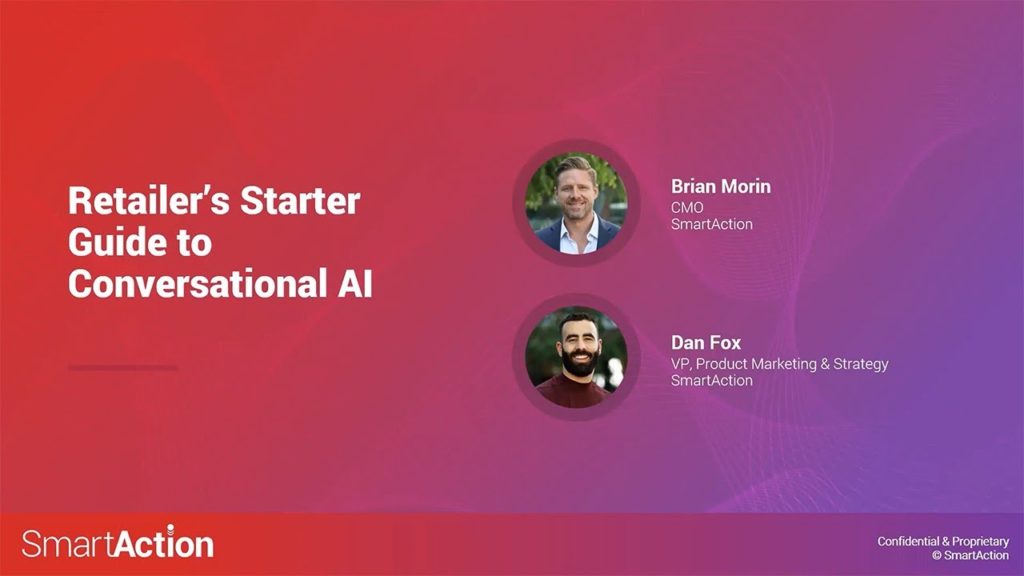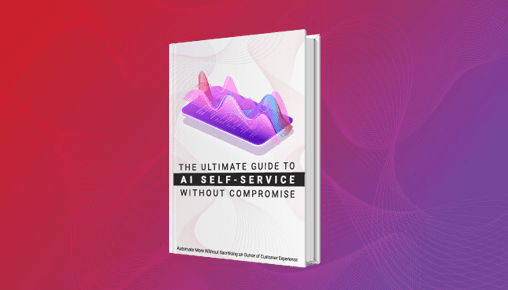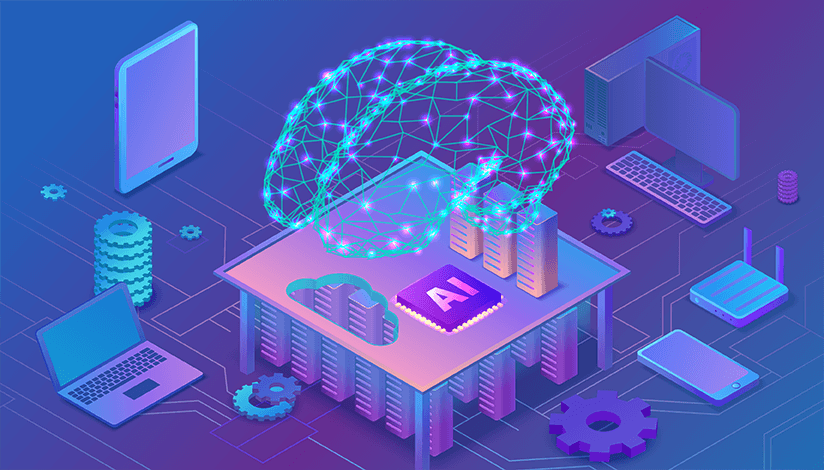Retailer’s Starter Guide to Conversational AI

It’s time for retailers to face the facts — customers are asking for new ways to interact with brands, and many of them no longer require a human agent.
Learn about the 4 ways retailers are winning with AI-powered Virtual Agents to save on the bottom line while delivering a CX that exceeds live agents when used the right way.
What You Will Learn:
- How to find the perfect fit for conversational AI
- The 4 top winning use cases for retailers
- Real-world examples from 5 leading retailers
- How to design virtual agents that outperform live agents
Watch This
Webinar

Brian Morin
Chief Marketing Officer,
SmartAction

Dan Fox
VP, Product Marketing & Strategy,
SmartAction
Retailer’s Starter Guide to Conversational AI
On-Demand Webinar
Brian Morin: Well good afternoon everyone. My name is Brian Morin. I’m the head of marketing here at SmartAction. Boy, when you start off a webinar and you’re trying to say the word marketing and SmartAction at the same time. Dan, this cannot be a good indication for those in our audience today. With me as my colleague and cohort, Dan Fox. He’s head of product marketing strategy over here at SmartAction, has been involved in the self-service voice automation space for years. One of the best in the business. Dan, good to have you here today.
Dan Fox: Hey, good morning.
Brian Morin: So just setting the table for those that are joining in. We’re talking very specifically about the Retailer Starter Guide to Conversational AI. There’s an accompanied eBook that we put together that we believe is the first of its kind that a lot of work was put into that essentially lays out the blueprint that retailers are taking.
We here at SmartAction operate conversational AI for more than a hundred brands. One of our largest verticals that we support is retail. And so this really put us in a unique position to see what does work in retail, what doesn’t work, what are companies doing, large best of breed retailers doing what are they not doing? And so we’ve had this front row seat really just watching this trend shift really from, who we might call the early adopters to know who we would call the early majority. Now those of you who are joining in right now, we should mention that you should have already received your pizza, if by any chance you have not. We have a team at Domino’s on the edge of their seat waiting to uncover status and make sure that it gets over to you. A lot of times that can be security, that might be holding up at your location. But if you do have a question, chime into the Q and A box or the chat box and somebody will uncover that status for you quickly.
So as far as where we’re at right now on this curve of your AI adoption capabilities and affordability, we’re really are past that curve where the AI technology is really, really good and at the same time costs have come down dramatically. It used to be that you couldn’t even get a voice automation package, without shelling out at least a million dollars on speech rec licenses and then all the professional services involved, to build it and maintain it and then wonder, would it even work or would you even get your ROI? So in this day and age customers can get started with little to no cap X investment and little to no risk. A mere 50K setup fee and then just a simple per minute usage.
Usage fees straight out of their op ex budget, which is offset by the natural churn of FTEs that just no longer need to be replaced until your right size, since you are ultimately deflecting a lot of the call volume and chat volume that would otherwise be coming in. So I should mention today is not meant to be a SmartAction commercial, although you may have to forgive Dan and I a plug here and there. But I should mention that as we’re jumping in, Dan, let me know just to make sure that you are seeing the advancement of the slides here too about the SmartAction so that everyone can see that?
Dan Fox: Yep.
Brian Morin: Okay, good. So just before we jump in, you might wonder, “well who’s doing the talking here? Do we have any street cred or any authority to be standing on, to be speaking on the subject that we are talking about today?” Now, I don’t like long company overview slides so I will make this quick and painless.
The only need to know really on the screen is that we deliver AI power virtual agents as a service. What that means is that we deliver the full conversational AI technology stack and that we bundle it together with end to end CX services. All the CX services needed to run it and that means everything, the design, the build, the ongoing operation. And most will start in voice first for the biggest ROI and then scale that digitally and we’ll chat more about that.
It is worth mentioning though that conversations with machines, it’s not easy. It was not just like the days of IVR where it’s design, build and poof, you’re done. That’s why you do need a team of specialists committed to tuning the application week by week. That means pouring through data and analytics, listening to call recordings, meeting with your team weekly on stats and objectives and you’re walking through that constantly, that process of perpetual improvement where you’re iterating and you’re chasing the most frictionless experience possible for your customers.
And we’d like to think that that approach has been working for us. Our customer reviews have made us a top rated solution on Gartner Peer Insight. So if you are interested in our street cred, you can go read all of those there. So, what’s the best place for us to start here in this conversation before we start getting into what we’re going to call out as a top four use cases for retail. The eBook goes into this much deeper, but we’re going to glance over the four top use cases and examples of those use cases with different retailers, not just what they’re doing but what it means for their business. But from a conceptual level, it’s better to start here on this slide. So just to understand or ask the question, “Why conversational AI for retail?” So as frustrating of course, as it is for all of us. A Touchstone experience that can be, you’ll link sitting there and you’re sitting through a lengthy phone tree menu, which we all hate. It isn’t the worst part.
It has to do with the fact that that offers you zero opportunity to improve efficiency and lower costs. And the same thing could be said if it’s just very simple chat bot application. So on the IVR side, since it can only offer the simplest forms of self-service like payment. Which I’d expect most of you are doing now, but likely not much more beyond that. It means that your customer service reps are handling almost everything, including all those simple interactions that are highly repetitive and transactional in nature. In fact in retail more than any other verticals, so many of those interactions are repetitive and transactional in nature. Which is why we have such a footprint in retail. And so for your live agents, that creates a very mundane employee experience. When we first started working with Electrolux, one of the top appliance manufacturers, their live agents, we’re handling 35 product registration warranty calls a day.
I mean the work was so mind numbing, the agents would literally be reading a magazine while doing the call. Another customer of ours we’ll talk about in a minute, TechStyle Fashion Group. They flew their CEO to the Philippines just to sit in the desk of a customer service rep for a day. And after doing that for one day, he walked away and said, “There has to be a way that we can automate at least half of this.” So whenever you step into the world of conversational AI on the right hand side of the screen, it’s not just a matter of automating some of those simple transactions. I mean those are clearly the most obvious, but you can actually begin to go a lot deeper than that and automate some very complex interactions as well. And here’s where the symbiotic relationship between virtual agents and live agents begins to emerge.
And this is where your job and your role as a customer care leader or contact center leader begins to change and evolve with it. A good example is with one customer that we work with, it’s a complex extended conversation. There’s 17 back and forth turns in the conversation. It involves capturing long alphanumeric policy numbers as fast as they can say them. I mean, that’s hard even for a human to do. Obviously impossible for an IVR. But as you can imagine in 17 back and forth turns into a conversation that presents a lot of different forks in the road for a conversation to go. And so somebody on the outside where automation is a big black box, they might look at that and they go, “Oh no, that’s far too complex for a virtual agent to handle.” But you have to keep in mind that the virtual agent is not intended to be designed and built in such way to handle every single exception that can occur on that call.
Because there’s many exceptions that can occur. What we’ve done is that we’ve designed swim lanes for virtual agents that follow what we’d call the happy path or the widest path, that most customers can take where we guarantee a great CX. Using the business logic to create business rules from your data, using customer data to establish those guard rails. Because it just isn’t worth the cost and effort to automate for every possible exception.
But here’s where that symbiotic relationship with it comes in with live agents. And this way you see the puzzle doing the connection on the right hand side of the screen, is because any call that goes outside the happy path designed for the virtual agent, well those calls just get transferred to the live agent along with the data gathered up to that point so they can pick up the call and finish it. And so what it does mean is that AI is not automating everything. It’s automating the widest path that most callers take, and then you transfer the exceptions to live agents. So now, humans are handling what really only human’s should handle. Those issues that are a little more complex, might involve some judgment or complex critical thinking. And so this symbiotic relationship is designed in almost every single call or chat that we automate where we handle the transactional pieces while transfer to a live agent when more is required.
So what we are going to do is just show you the very first use case. We call this an intelligent front door. I’m going to play this clip and so you get just an idea of what this sounds like and then Dan will jump in from here.
Dan Fox: Sure.
Brian Morin: Oops, let’s try that again.
IVA: Hello. Thank you for calling Fabletics. How can I help you today?
Customer: Billing.
IVA: I’d be happy to help you with your billing question. Is the name on the account, Sarah Peters?
Customer: Yes.
IVA: Are you calling about the $49.95 charge billed on or around July 19th.
Customer: Yes.
IVA: Okay. What’s your question regarding this charge?
Customer: I skipped the month. I should not have received this charge.
IVA: Looks like you were charged because you did not make a purchase or skip by the fifth of the month. This charge is added to your account as a member credit that you can use at any time. Would you like to keep the credit in your account?
Customer: No. I’d like to be refunded the money as I skipped the month on July 3rd.
IVA: Okay. No problem. Your refund has been successfully processed. Please note that it may take up to seven business days for your bank account to reflect the change. Is that everything for today?
Customer: Yes. Thank you. I appreciate that.
IVA: Thank you for your call and have a great day.
Customer: Bye-bye.
Dan Fox: All right, so just to jump in there, that’s a, that’s an interesting use case from TechStyle who as a subscription retailer gets calls like this all the time. They get customers who want to skip the month, they have billing questions. That really gives you a full scope of what conversational AI is capable of from greeting the customer in a personalized manner down to really helping the customer self a challenge that typically would be handled by a live agent. That call all in all took a minute and a half for the virtual agent compared to what probably would have been six or seven, maybe more minutes for a live agent to handle. So TechStyle uses that virtual agent in a variety of manners. When you call them up, when you chat with them, there’s a huge productivity gain that they get from allowing customers who get transferred to a live agent, having context of where they were with the virtual agent and of course by fully self-serving a bunch of different functions.
So all in all TechStyle sees 1.1 million in annual savings from that application. And within contained calls like the ones that you heard, that represents nearly 20% of their call volume that doesn’t have to go to a live agent anymore as well as an overall reduction in their handle time of 45 seconds. What’s really interesting from a customer experience perspective, is that they measure the virtual agent with the same customer satisfaction metrics that they do the live agent. And what they find is the virtual agent performs nearly just as well as the live agent with a 92% member satisfaction score.
So just to speak to some of the capabilities that you heard within that TechStyle example. These are the core tenants that we apply when we are talking about conversational AI. The first is the ability to navigate a complex multi turn conversation like you heard. That involved several back and forth or it’s really bartering, understanding what the customer was asking for and then providing a contextual reply. One of the most important points, routing exceptions to a live agent. And so if for any reason that customer requested to talk to a live agent, our goal isn’t to trap customers with the conversational AI but to self-serve those who want to use the system. So if for any reason by design or otherwise the customer needed to get to a live agent, we’re able to do so and give it that live agent context of what happened during that dialogue.
Omni channel. So the experience that you heard was over voice. If you go and chat with TechStyle as well, you’re going to interact with the same AI and the system that they leverage. Recognition and cognition. So this is more than just basic keyword and understanding the true natural language processing. So when a customer says something like, “Hey, I made a payment by the third of the month, I shouldn’t have been charged.” And using prediction. So understanding why customers are calling and being able to leverage that within the context. So you heard that at the beginning of the call when the virtual agent said, “Are you calling in reference to the charging proceeded of this amount on that date?” And of course being connected to the same data as live agents. So this is often overlooked. This is really the cause of bad automated systems. What you need to do is make sure that whatever you’re live agents have access to that conversational AI application has the logic assigned to it as well.
Brian Morin: Good. So with that in context, I’m just going to play this. That’s just a 90 second clip from DSW, Designer Shoe Warehouse. We’re talking about use case number two, which falls under order management. So we’ll give you a quick example of that.
IVA: Thank you for calling DSW, Designer Shoe Warehouse. You’ve reached Shoephoria. Am I speaking with Holly Simms?
Customer: Yes.
IVA: To verify your account, please tell me the zip code listed on your account.
Customer: 9516.
IVA: Great. I was able to find your account. What would you like to do today?
Customer: Address change.
IVA: Are you calling about order number 304?
Customer: I think so.
IVA: Do you want to change your billing address or your shipping address?
Customer: Shipping address.
IVA: What’s the five digit zip code of the new address?
Customer: 98516.
IVA: Okay. From the zip code, I already know your city and state. Please say just the first line of your shipping address such as 1234 main street.
Customer: 7838 Martin Way East, unit 17.
IVA: Now from each part of your address was the house number 7838?
Customer: Yes.
IVA: What’s the street Martin way?
Customer: Mm-hmm (affirmative) right.
IVA: Was the apartment or unit number, number 17?
Customer: Yes.
IVA: Thanks. I have your complete street address 7838 Martin Way East, number 17 Olympia, Washington 98516. Is that correct?
Customer: Yes, correct.
IVA: Great. Address change request for this-
Brian Morin: I think that we heard at least enough to get through there and gives you some idea. You see some of those capabilities that Dan was talking about. The predictive capabilities to know what they are calling about and you can see that when you’re designing a voice application, the level of handholding that is involved and another good showcase on how good these speech recognition engines are now, when it comes to handling like accents, because I would challenge anyone to be able to have understood exactly everything that she said, the way that she did as well as the system did it. So DSW on screen, just like a lot of our other retailers, they are doing more than just order management. They’re also doing the intelligent front door, which is authenticating, be it capturing intent, routing or keeping in self-service, doing account updates, password resets and more.
But under the umbrella of order management, retailers will usually start with order status. “Where is my order?” Before moving on to other things like returns. Some will also throw in change shipping options or address. Or I mean change shipping options, change shipping address just like we heard. And DSW just in Q4 of last year, they presented their findings at the university of Wisconsin at a conference on how AI initiatives are impacting companies. And for them it meant a 19% reduction in agent hail time. It meant, more significantly a 1.5 million first year savings. As far as you’re wondering, “Well how did this impact C-SAT, things like that?” Well in their very first month of production their C-SAT jumped 30%, and that was simply just because their customers no longer had to hold to speak to a live agent.
They were able to self-service very quickly what they needed to get done. And this year we were rolling out new applications with them that will offload even more time and we’re taking all the applications in the voice channel and we are scaling it out to chat for them. So just one other example, this would just be a little bit different and I’ll say this just very short, succinct. When it comes to office Depot, office Depot identified returns is a great place to start with virtual agents.
As you know, returns can be a very complex interaction. But as it turns out, most people who are doing a return, they just want a refund. And so for office Depot, like I’d mentioned earlier, we’re not attempting to do the entirety of every return interaction. What we have identified is that wide path, that wide swim lane, when it comes to order returns, where they just want a refund. And so those interactions where they want refunds, those stay with the virtual agent because it is linear or near linear and transactional in nature. You can see the results onscreen. What that meant for them, and obviously meant quite a bit from a results standpoint. So Dan, why don’t you talk a little bit about this, how conversational AI is not a product?
Dan Fox: Sure. So this is a super important point when we’re looking at the market and I think there’s a lot of disillusionment of one conversational AI is capable of and the timeframe that it’s capable to deliver results in. And at the end of the day, the way that we see it, conversational AI is a solution. The same way that web design and web development, you don’t trust simple website builders to build a website, although they are available. And we see a lot of discussion in buy versus build. And we just want to make sure that you know, that you guys understand that conversational AI involves two parts. That’s the core underlying technologies of speech recognition and natural language processing and data integrations. But huge point on top of that is the services, and making sure that this product and these technologies are enabled in a way that is able to deliver successfully the ones that you heard from DSW and TechStyle.
And another aspect of this that I just referred to is, do it yourself or partner? So we know that this is a huge conversation in the market right now, especially with some do it yourself tools from Amazon and Google and IBM. So we just want to throw out our suggestion when you’re looking at this model, do it yourself is certainly an option. And we just want to make sure that you guys understand the team that’s involved in that model.
And it’s pretty similar to web development. So when you design a website, you need someone to code the logic behind it. That’s an engineer, you need someone who writes the copy, you need someone who does graphic design, and you need someone to manage the project. And in a lot of ways, conversational AI is very similar. You need a team, we call it a CX team that really handholds a project from beginning to end. So we think that both approaches are valid as long as you know, if you do follow the do it yourself model, you will have to build out that team internally, including the hiring and training and then figuring out what those people do once the project is up and running. And how do you keep the application performing at its best.
Brian Morin: So Dan, to the point you’ve mentioned earlier, conversational AI is not a product, it does take a team. It does require ongoing operation care and feeding. So this is just an image at least of our own internal team that we have curated, seven different teams across seven different CX disciplines. Maybe you can step us through it.
Dan Fox: Sure. And it really starts with identifying where the biggest impact areas are going to be and what automation opportunities are going to succeed. And then designing what they’re going to sound like and what the experience is going to look like. Down to coding, the integration points, quality assurance. And then most importantly you get it up and running, but are you monitoring it for success? Are you looking at the right ways to improve the application? Because once it gets out the door, it’s not going to perform that way forever. It’s going to take constant care and feeding. And that takes a customer success team as well as having data scientists and analytics folks constantly monitoring the performance.
So this is an interesting example for the third use case that we wanted to mention for retailers, which is product registration. So, we won’t bore you with playing these calls, but we did want to give you an example of what product registration could look like by leveraging data in an intelligent way. So for Electrolux, when you call Electrolux, they often… You may have a product registered from them, but oftentimes customers don’t. If you buy your refrigerator at Home Depot, oftentimes Electrolux has no idea who you are. So when you do need customer support, you need to register that product. We need to capture your serial number, your customer information. So, that’s what we do for Electrolux.
We do recognize if a customer is a repeat customer or a repeat caller, get them right to the place if they’re already registered by leveraging call history. If they’re a registered color and then we have to figure out who they are. And with that we can authenticate them by their phone number or by capturing their account information, or any other information that allows them to identify who they are. The most important part is that new caller registration.
So if no one has registered the product before and they don’t have an account with Electrolux, we have to go through a full product registration. So along with guiding the customer on how to find that serial number, we leverage data sources like 411. So rather than saying, “What’s your name and address?” We can go proactively, look up your phone number and say, “Okay, we think this is Dan Fox and we think this is his address.” And then we say, “Hey are you Dan Fox?” Rather than collecting that name and then we can confirm that information. So we can actually handle product registrations in just under two minutes, which is a process that typically takes up to four minutes for a live agent.
Brian Morin: Yeah. Now I do want to mention we will be moving to vote Q and A here at the bottom of the hour. So if you have any questions or comments you can put that into the Q and A box or the chat box. I will just mention-
Speaker 6: Hello this is Iva-
Brian Morin: Well there we go. So I will just mention just on this slide when we’re looking at from a result standpoint, when you do look at… At least for them with Electrolux, they had identified product registration warranties, that was the best place to start with virtual agents. As Dan mentioned, this was taking, at least from the virtual agent standpoint a little more two minutes for the virtual agent to do. And there’s quite a bit of complexity involved, here because it involves capturing the customer name, it involves capturing product name, model numbers, long serial numbers and things like a date of purchase.
So six months into their implementation they presented their findings and an Execs in the Know conference in Santa Monica, a conference for customer care and customer experience executives. And they showed that the virtual agent was as successful as their live agent in completing the interaction. They were doing it more quickly than the live agent. But there was one big difference, is that the virtual agent according to their findings and their ROI calculations was roughly 1/10th the cost of a live agent on handling the same call. So Dan, do you want to take us through use case number four?
Dan Fox: Yeah, sure. So a big use case that we find is account management and account updates. We do a lot of this for a company called Purchasing Power, who is a retailer, also a little bit of a financial services organization that gets a ton of calls about stuff that your agents shouldn’t really be handling. Like a password reset or updating an address on file or updating a shipping address. So Purchasing Power allows you to do that all conversationally through greeting the customer with an intelligent front door and then completing those account updates. Through that process what they actually recognized was a 17% improvement in net promoter score versus having all live agents. Really interesting use case, I think that goes to show that, for a lot of companies who are looking at conversational AI and thinking, “Should I do that for my business? How will my customers react to it? My customers want to talk to people.”
I think that is an old way of thinking. I think a lot of retail organizations within the last three years have realized, “Hey most of my customers just want to get an answer quickly.” And a conversational AI application may be the quickest, best way for customers to get information. So that’s really what Purchasing Power adopted in their philosophy, and the net promoter score improvement that they’ve seen really speaks to that. On top of that, a quarter of their calls are now removed from the contact center and handled with the AI application and they also recognized an ROI on that within the first three months of deploying.
Brian Morin: Yeah. In fact, I will tag along with this. Because of our work with them, they’ve won two awards here just in the last three months. One of them was winning the excellence in self-service award from Frost and Sullivan. And separately, this happened just last week. They won the Stevie award for a best return on customer service investment. You can see that they’re showing a three month ROI and you may wonder, “Well how do you get to a three month ROI?” And it’s essentially the same way that of our customers get there, which is, it’s very, very low cost, just a nominal setup fee to get started. And then you’re just paying usage typically straight out of your OPEX budget. And in this case, the moment that we go live with Purchasing Power, we’re offloading 25% of their call volume.
Now did they just go out and lay off 25% of their live agents? No. In fact, we’ve never seen a customer do that. However, what we have seen with every customer of ours is they have to, as you do experience heavy churn. And that’s one of the most difficult parts of being a contact center leader, is the constant churn, the constant training, the constant new hiring. We see customers of ours who have situations of 100% churn within the organization. And so for them, in order for them to achieve their ROI, they just simply didn’t have to replace any of their full-time head counts until they had right size as an organization. And what that meant for them is that they had paid for the whole solution within three months and put them on a path for a very, very nice ROI after its first year.
So I will go ahead and wrap up and close and then we will move to Q and A. So please go ahead and just chime in any questions that you have and then we’ll answer. And you can keep us on as long as you have questions coming. But just as a wrap up, why is it that we do know so much about this? I’ll give you this just 60 second elevator pitch on why customers choose SmartAction. If you are looking, considering either your own approach or working outsourced with a vendor. The most important piece from a top level is that we are proven in the marketplace as fragmented as the market is. It can be hard to find out who the leaders are in this space. We operate conversational AI for more than a hundred organizations. Very large brands among them, among the Fortune 500. And to our customer reviews do have us as the number one rated solution on Gartner Peer Insights.
But the biggest reason, I’d say that customers ultimately end up working with us. As you see that second part, it’s outsource instead of do it yourself. You can go down that path of do it yourself, but it means that all that CX team that Dan showed in front of you is all internal headcount that you have to hire to work those disciplines. Which ultimately just the costs of doing that for most any organization unless perhaps you’re a top four financial firm just outweighs the ROI.
And so for us we can step in and we can do that much more cost effectively. And obviously since we’re doing this for a lot of brands, it’s proven we have templates in place and can jump right in, which really makes us more of a partner than a technology provider. We’re not selling software licenses. We’re working as an extension of your team and that’s because we’re ultimately responsible for delivering on the ROI that was promised and delivering on the CX that was promised.
And last but not least, customers can start small, grow over time. You don’t have to jump in and do a high risk big bang implementation, but start a small as you want to. Now, once this webinar is over, we will send you a link to our retailer starter guide on conversational AI. As far as we know, this is the only blueprint like this in the marketplace for retailers that gives a complete breakdown on what leading retailers are doing with conversational AI, where they have it deployed and the results that they’re seeing from it. So when this webinar’s over, we’ll make sure that we get a copy of this deck and a copy of this book over to you that you can review yourself and share it with stakeholders.
And finally, before moving to Q and, A if you are interested in next steps, next steps usually go down one or two paths, one is requesting a demo just so that you can see and hear what we’re doing for other retailers and how we can be like-minded with your organization. Or the other piece of that is what we call free AI readiness assessment.
Not every interaction is great for automation. In fact, in some cases the interaction, the nature of the interaction might be perfect for automation. But there just may not be enough volume coming through in which it makes sense to step over that key threshold for change. So if you’d like to understand what the key threshold is for change on any given interaction, just engage with us. We have someone that’s happy to sit down with you and do a rough behind the napkin math on the ROI and see how we can help you within your organization. So with that said, if you have a hard stop, we’d like to thank you for joining and for those that are hold on and have questions, we’ll go ahead and start taking some questions now. And Dan, I have here one of the first ones, just a couple right away. First is asking, “Can you speak to how often the AI application needs to be tuned?”
Dan Fox: Yeah, I think that’s an ever evolving task. I think that the minute something goes live, it needs to get tuned and continue to get tuned. Because customers will always interact with an AI application in unexpected ways and you always have to be responsive for that and catch it so you’re improving the application. For example, you go live with order status and then someone says, “Where’s my stuff?” And the application doesn’t recognize that. You need to make sure that the next time someone says, “Where’s my stuff?” They’re actually asking for an order status. So that evolution is ongoing and doesn’t ever stop.
Brian Morin: So Dan, this is a really good question. “Are your competitors offerings things like AWS, Salesforce Einstein?” Which I believe that they’re chat only might as well throw in others, like an IBM Watson.
Dan Fox: Yeah, those are all options. I would say those closer align to the build on your own. They require a lot of heavy lifting. They require experts who know how to wield those tools effectively. So, back to the build verse buy, if you do have the team place to leverage those tools, I think it’s a decent approach. If you’re not an expert and you don’t have plans to hire that staff, then trust a hosted solution to take care of it for you.
Brian Morin: Yeah. Dan, here’s a good one. It almost sounds like when you were talking in the intelligent front door, it almost sounds like the virtual agent is outright replacing the IVR. Is this true?
Dan Fox: Yeah, for sure. I think IVRs are pretty antiquated. If you’re able to leverage a lot more data and design experience that actually works for our customers, then it’s our own approach that you can totally replace your IVR with. Other than that, if you do have heavy investments in your IVR, there may be innovative ways that you haven’t thought about to integrate your IVR with that virtual agent.
Brian Morin: Yeah, I would say about 80% are using us as their IVR replacement just so they get that, “How can I help you today?” Greeting and natural language instead of the, “Press one.” But we do it about 20% of our customers that do put our virtual agent behind their IVR. One example is Office Depot that we mentioned earlier. If you press a certain number for returns then you’ll be greeted by a virtual agent. So we’re augmenting there. Another case is non retail. But with AAA, very large organization, it begins with a press one or press two experience and we handle their end-to-end emergency roadside assistance. And so in those cases it’s transferred over to the virtual agent. So it can be an either or. Dan, a question here on, “How difficult is the integration with our CRM and our Genesis platform?”
Dan Fox: Yeah, and to make any conversational AI application home, you need two things, a data integration point, and you also need a integration with telephony. Luckily for you, most of the systems that you probably already have in place do have APIs accessible where you can integrate. If you do have more of a homegrown system. That may be a longer effort, but for sure you do need those data integrations up and they can be really easy or really complex depending on what they look like.
Brian Morin: Well, so that’s all the questions that I have seen come in. So I do want to thank everyone for their time. As mentioned, we will get the eBook over to you and as soon as this webinar has rendered, we will issue an on-demand version. Likely won’t be ready by today, but perhaps sometime by tomorrow. One of our account reps who manages retail will be reaching out and sending that along so you can review that with stakeholders as well. And Dan, any closing or final remarks from your end?
Dan Fox: All right. I hope you guys enjoyed the pizza.
Brian Morin: Yeah, absolutely. So thank everyone for the time and we hope to be chatting with you soon, thank you.
Dan Fox: Alright, thanks.





